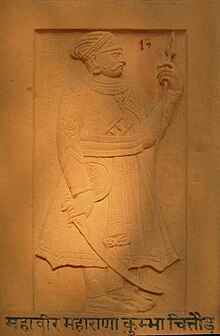Sisodia

The Sisodia is an Indian Rajput dynasty belonging to the clan ruled over the kingdom of Mewar in Rajasthan.[1]The name of the clan is also transliterated as Sesodia, Shishodia, Sishodia, Shishodya, Sisodya, Sisodiya, Sisodia (Ranawat Rajput).
Origins[]
The Sisodia dynasty traced its ancestry to Rahapa, a son of the 12th century Guhila king Ranasimha. The main branch of the Guhila dynasty ended with their defeat against the Khalji dynasty at the Siege of Chittorgarh (1303). In 1326, Rana Hammir who belonged to a cadet branch of that clan; however reclaimed control of the region, re-established the dynasty, and also became the propounder of the Sisodia dynasty clan, a branch of the Guhila dynasty, to which every succeeding Maharana of Mewar belonged, the Sisodias regain control of the former Guhila capital Chittor.[2][3][4]
According to the Rajprashasti genealogy, one of these – Samar Singh – married Prithi, the sister of Prithviraj Chauhan. His grandson Rahapa adopted the title Rana (monarch). Rahapa's descendants spent some time at a place called Sisoda, and therefore, came to be known as "Sisodia".[5]

History[]
The most notable Sisodia rulers were Rana Hamir (r. 1326–64), Rana Kumbha (r. 1433–68), Rana Sanga (r.1508–1528) and Rana Pratap (r. 1572–97). The Bhonsle clan, to which the Maratha empire's founder Shivaji belonged, also claimed descent from a branch of the royal Sisodia family.[7] Similarly, Rana dynasty of Nepal also claimed descent from Ranas of Mewar.[8]
According to the Sisodia Chronicles, when the Delhi Sultan Alauddin Khalji attacked Chittorgarh in 1303, the Sisodia men performed Saka (fighting to the death), while their women committed Jauhar (self-immolation in preference to becoming enemy captives). This was repeated twice: when Bahadur Shah of Gujarat besieged Chittorgarh in 1535, and when the Mughal emperor Akbar conquered it in 1567.[9]
Frequent skirmishes with the Mughals greatly reduced the Sisodia power and the size of their kingdom. The Sisodias ultimately accepted the Mughal suzerainty, and some even fought in the Mughal army. However, the art and literary works commissioned by the subsequent Sisodia rulers emphasized their pre-Mughal past.[9] The Sisodias were the last Rajput dynasty to ally with the Mughals, and unlike other Rajput clans, never intermarried with the Mughal imperial family.[10] The Sisodias cultivated an elite identity distinct from other Rajput clans through the poetic legends, eulogies and visual arts commissioned by them. James Tod, an officer of the British East India Company, relied on these works for his book Annals and Antiquities of Rajasthan, or the central and western Rajpoot states of India (1829–1832). His widely read work further helped spread the views of the Sisodias as a superior Rajput clan in colonial and post-colonial India.[9][11]
List of Rulers[]
- Hammir Singh (1326–1364)
- Kshetra Singh (1364–1382)
- Lakha Singh (1382–1421)
- Mokal Singh (1421–1433)
- Rana Kumbha (1433–1468)
- Udai Singh I (1468–1473)
- Rana Raimal (1473–1508)
- Rana Sanga (1508–1527), Under his rule Mewar reached its pinnacle in power and prosperity.[12]
- Ratan Singh II (1528–1531)
- Vikramaditya Singh (1531–1536)
- Vanvir Singh (1536–1540)
- Udai Singh II (1540–1572)
- Maharana Pratap (1572–1597), 13th king of Mewar, notable for his military resistance against the Mughals.
- Amar Singh I (1597–1620)
- Karan Singh II (1620–1628)
- Jagat Singh I (1628–1652)
- Raj Singh I (1652–1680)
- Jai Singh (1680–1698)
- Amar Singh II (1698–1710)
- Sangram Singh II (1710–1734)
- Jagat Singh II (1734–1751)
- Pratap Singh II (1751–1754)
- Raj Singh II (1754–1762)
- Ari Singh II (1762–1772)
- Hamir Singh II (1772–1778)
- Bhim Singh (1778–1828)
- Jawan Singh (1828–1838)
- Sardar Singh (1838–1842)
- Swarup Singh (1842–1861)
- Shambhu Singh (1861–1874)
- Sajjan Singh (1874–1884)
- Fateh Singh (1884–1930)
- Bhupal Singh (1930–1947)
Titular Maharanas[]
- Bhupal Singh (1947–1955)
- Bhagwat Singh Mewar (1955-1984)
- Mahendra Singh Mewar (1984-Present)
See also[]
- Rajput clans
- Shaktawat
- Chundawat
- Ranawat
References[]
- ^ For a map of their territory see: Schwartzberg, Joseph E. (1978). A Historical atlas of South Asia. Chicago: University of Chicago Press. p. 147, map XIV.4 (e). ISBN 0226742210.
- ^ Rima Hooja (2006). A history of Rajasthan. Rupa. pp. 328–329. ISBN 9788129108906. OCLC 80362053.
- ^ The Rajputs of Rajputana: a glimpse of medieval Rajasthan by M. S. Naravane ISBN 81-7648-118-1
- ^ Manoshi, Bhattacharya. The Royal Rajputs. pp. 42–46. ISBN 9788129114013.
- ^ Sri Ram Sharma (1971). Maharana Raj Singh and His Times. Motilal Banarsidass. pp. 2–12. ISBN 9788120823983.
- ^ Wessly Lukose (2013). Contextual Missiology of the Spirit: Pentecostalism in Rajasthan, India. Wipf & Stock Publishers. p. 50. ISBN 978-1-62032-894-1.
- ^ Singh K S (1998). India's communities. Oxford University Press. p. 2211. ISBN 978-0-19-563354-2.
- ^ Greater Game: India's Race with Destiny and China by David Van Praagh
- ^ a b c Melia Belli Bose (2015). Royal Umbrellas of Stone. Brill. pp. 248–251. ISBN 9789004300569.
- ^ Melia Belli Bose (2015). Royal Umbrellas of Stone. Brill. p. 37. ISBN 9789004300569.
- ^ Freitag, Jason (2009). Serving empire, serving nation: James Tod and the Rajputs of Rajasthan. Leiden: Brill. pp. 3–5, 49. ISBN 978-90-04-17594-5. Retrieved 27 July 2011.
- ^ "Maharana Sanga; the Hindupat, the last great leader of the Rajput race: Sarda, Har Bilas, Diwan Bahadur, 1867–1955 : Free Download, Borrow, and Streaming". Internet Archive. Retrieved 16 August 2020.
Further reading[]
- Gopinath Sharma (1954). Mewar & the Mughal Emperors (1526-1707 A.D.). S.L. Agarwala.
External links[]
- Rajput clans of Rajasthan
- Mewar dynasty
- Indian surnames
- Social groups of Rajasthan
- Suryavansha